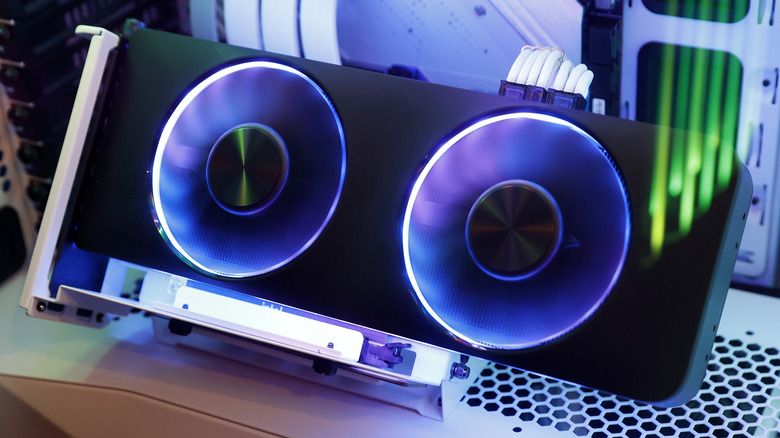Integrated Vs. Discrete Graphics: What Are They And Which Do You Need For Your PC?
A GPU, also known as a graphics processing unit, is one of the most important components in any computer. While you can't power up a PC or a laptop without things like a power supply or a processor, your device still can't run if it doesn't have a component responsible for presenting the graphics on screen. If your PC doesn't have any form of a GPU, it simply won't be able to boot properly. In this guide, we will talk about the different types of GPUs, and which one is best for your needs.
In the world of computing, graphics cards are split into two different sections: discrete (also referred to as dedicated), and integrated. Both can be found in desktop computers and laptops alike. Whether you build your own PC, or buy a ready-made device, you should always pay attention to the GPU section — and this isn't only important for gamers.
While it's true that gamers benefit from having a good graphics card, having a solid GPU is a requirement for many things, including content creation, streaming, 3D modeling, and all sorts of other professional use cases.
What are integrated graphics?
An integrated GPU (iGPU) is simply a graphics card that's been built into the central processing unit (CPU). It's significantly different from a standalone graphics card: It doesn't have its own video memory bank (also known as VRAM), and instead uses the same system memory that is utilized by the CPU.
Integrated graphics cards are typically a low-power, low-heat solution that still lets your computer boot and perform all kinds of day-to-day tasks without any issues. They're often found in ultrathin notebooks and laptops, but also in desktops that aren't aimed at gamers. As you can probably tell, this is because these types of GPUs are meant to conserve battery life (in laptops) and not consume as much power, as opposed to providing the best graphics performance available.
Integrated GPUs aren't the go-to pick for gaming PCs, but you can still game on systems that have them inside. Modern iGPUs are perfectly adequate for esports titles like "Apex Legends" or "Fortnite." The older models may struggle with a lot of games, but will still be able to handle older titles on lower settings.
Integrated graphics are common on both AMD and Intel processors. However, AMD also makes an interesting kind of chip called an APU (accelerated processing unit) that combines a separate CPU and GPU into a single die. Those APUs tend to offer stronger graphics performance than regular integrated graphics solutions.
What are discrete graphics?
The term "discrete graphics" or "dedicated graphics" refers to a standalone graphics card that is completely separate from other components in the computer. They come in many sizes, but most modern graphics cards feature a dual or triple-fan layout (as pictured above).
A discrete GPU uses its own dedicated video memory and communicates with the CPU separately — without being part of it. It also has its own power connector and plugs into the motherboard independently. Some of the latest graphics cards by AMD, Intel, and Nvidia are rather huge beasts, taking up to three slots on a motherboard.
While the GPU pictured above is a desktop card made by Intel, discrete graphics can also be found in laptops. Those models are less powerful than their desktop counterparts in order to account for the limited power consumption and heat control. However, high-end gaming laptops still come with powerful GPUs.
You will often find that desktop models and laptop models share the same names, but have different specifications. As an example, Nvidia's RTX 3080 Ti for desktops is considerably stronger than its laptop counterpart. However, that's just the nature of laptop gaming — the card is still among the best available in laptops.
Discrete graphics are recommended to gamers and everyone else who wants their PC to have stronger graphics performance. Some budget models are still not that great, but even a budget GPU will usually perform better than an integrated GPU. AMD's APUs are an exception here — the latest versions can rival some dedicated graphics cards from older generations.
Integrated vs discrete: Which do you need in your PC?
If you're shopping for a new desktop or laptop, you might be wondering whether you should buy one with discrete or integrated graphics. The good news is that all you need to know is your budget, and what you plan to use the computer for. Some people absolutely need a dedicated GPU, but many users will be just fine going down the integrated graphics route.
The main differences between integrated and discrete graphics stem from price and performance. If you need more performance in your computer, you should pretty much always choose a discrete GPU. However, if you want a lightweight laptop that will have a decent battery life, integrated graphics are the way to go.
The budget will also play a part: If you're building a very budget desktop yourself, you may find that it's better to just get a CPU with integrated graphics (or an AMD APU) instead of shelling out the cash for an old discrete GPU. Even low-end cards in the latest two generations will cost you a couple hundred dollars, so it might sometimes be more sensible to just get a decent processor.
If you are a gamer and you want to play new games, such as "Elden Ring," you will need a discrete graphics card — and a good one at that. In general, buying a GPU for gaming purposes will depend on the kinds of titles that you play. Indie gamers and those who love some "oldies but goodies" don't need a powerful GPU, but gamers who prefer AAA titles will definitely need a great graphics card. The same is true for professionals who work in content creation or 3D modeling.



